|

Dans les profondeurs de Roque Noire - In the depths of Roque Noire
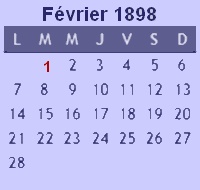 
|
Le navire
Le
Channel Queen avait été construit sous le n° 116 par les chantiers R. Craggs
& Sons de Middlesborough. Lancé le 13 Juillet 1895, il était achevé en Septembre
de la même année et délivré à son propriétaire, la compagnie Plymouth, Channel
Islands & Brittany Steamship Co. de Guernesey qui l'avait aussitôt mis en service en
en confiant le commandement à Edward James Collings. Le 17 Septembre, il
effectuait son voyage inaugural entre Plymouth et Jersey via Guernesey.
D'un tonnage brut de
350 tonnes, c'était un petit paquebot rapide long de 54 mètres, propulsé par une machine à triple expansion de 85 rhp
entraînant deux hélices. Aux essais, le navire avait atteint 16
noeuds. En Avril 1896, il était réaménagé et son tonnage était alors
porté à 385 tonnes.
|
The ship
The Channel Queen had
been built under yard N° 116 by R.Craggs & Sons at
Middlesborough. Launched on July 13rd, 1895, she was completed in
September that same year and delivered to her owner, Plymouth,
Channel Islands & Brittany Steamship Co. of Guernsey. She entered
immediately in service under command of Captain Edward James
Collings and made her maiden trip on Sept. 17th between
Plymouth and Jersey via Guernsey.
This little and
fast passenger ship long of 177 ft had a gross registered tonnage of 350
gross tons and
was engined with a reciprocating triple expansion steam engine
of 85 rhp, inked
with twin propeller shafts. During trials, she had reached 16 knots.
Following an overhaul in April 1896, alterations
were carried out and her tonnage increased to 385 tons |
|
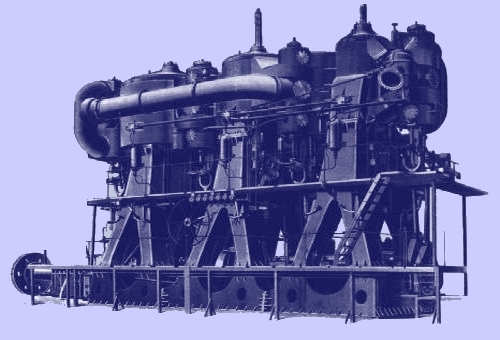 |
Machine à vapeur
à triple expansion -
triple expansion steam engine |
|
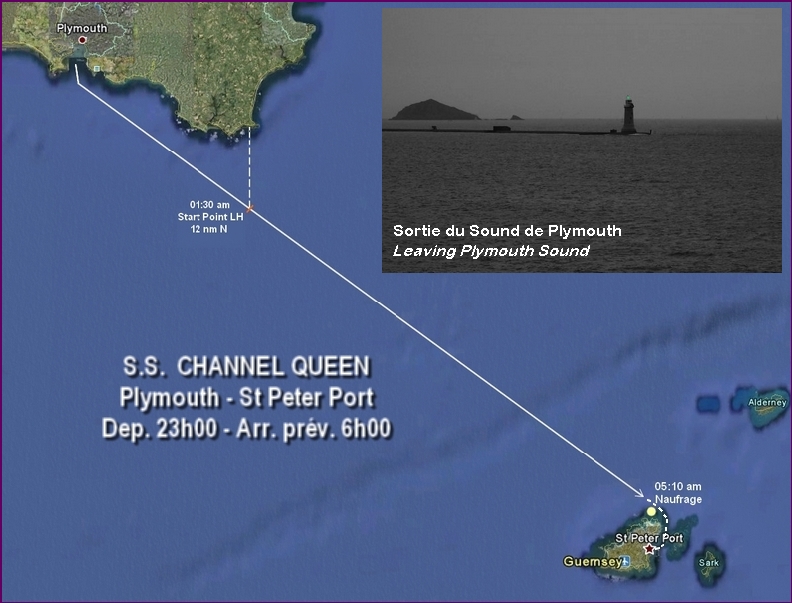
|
|
La dernière traversée
Le Channel
Queen
avait appareillé de Plymouth au soir du 31 Janvier 1898
à destination de St Brieuc, port du Légué, avec escale à
Guernesey, St Pierre Port et Jersey, St Helier. Quarante huit passagers dont 44 Johnnies, ces
bretons paysans et parfois marins qui vendaient leur récolte d'oignons en
Angleterre, plus 15 membres d'équipage sous le commandement du Capitaine
Collings et de deux officiers.
A 23 heures
10, le Channel Queen passait Mewstone Rock à la sortie de
Plymouth et mettait le cap au SSE ayant envoyé une voile d'étai
au grand-mât et une misaine à l'avant. Le Channel Queen
poursuivait alors sa route à une vitesse de 12 nœuds. La brume
puis des bancs de brouillard étaient alors observés et sa position
estimée à 1 heure 30 du matin le plaçait dans le S de Start
Point à une distance de 12 à 13 milles. Plus tard dans la nuit,
alors que le navire approchait de la côte NE de Guernesey, la
visibilité se détériorait encore.
Peu
avant 5 heures, l’Officier de Quart appelait le Capitaine qui montait aussitôt à
la passerelle. A 5 heures, le Capitaine Collings donnait l’ordre de réduire la
vitesse et de venir sur bâbord pour mettre le cap vers le large. Au cours de
cette manœuvre, on apercevait soudain des brisants sur l’avant et ordre était
aussitôt donné de venir à gauche toute mais c’était trop tard. Presque aussitôt
le Channel Queen heurtait Roque Noire, un dangereux récif sur la côte
nord de l’ile. Il commençait aussitôt à faire eau tandis que l’équipage tentait
de mettre les canots à la mer. Le premier d’entre eux fut projeté contre une
manche de ventilation et ne put être lancé, le second fut lancé correctement
mais surchargé, il chavirait. La troisième embarcation appelée aussi « jolly
boat » était en fait le youyou du bord. Il était mis à l’eau sans encombres
et après un temps considérable atteignait enfin la côte avec quelques naufragés. |
The last crossing
The
Channel Queen had sailed from Plymouth on the evening of
January 31st, 1898, bound for Saint Brieuc - Le Légué with stops
at St Peter Port, Guernsey and St Helier, Jersey. There were
fourty eight passengers amongst whom were 44 Johnnies. The term
Johnnies is a term used to describe Breton onion sellers who
were usually men and who used to travel around Great Britain,
often on bicycles, selling their onion crop. There were also 15
crew on board the Channel Queen together with the Captain
and two officers.
Channel Queen passed the Mewstone rock off Plymouth at 11.10 p.m
and set sail on a SSE course with a main trysail and fore
staysail set. The Channel Queen proceeded on that course
at a speed reported as 12 knots. Mist and occasional thicker
banks of fog were observed. Her position was reported at 1.30
a.m. as approximately south of the Start Point light house which
was estimated at a distance of some 12 or 13 miles away. Later
fog reduced visibility as the Channnel Queen approached
the north east coast of Guernsey.
Just before
5.00 a.m. the officer of the watch called the Captain who
immediately went to the bridge. At about 5.00 a.m. Captain
Collings ordered reduced speed with a turn to port to take the
vessel further out into the English Channel. Whilst the
Channel Queen was being manoeuvred waves were seen breaking
on a reef and the order was then given to turn hard to port, but
it was too late. Almost immediately, the Channel Queen
struck Roque Noire, a dangerous reef on the north coast of the
island. She sprang a leak and immediately started to flood while
the crew attempted to launch the boats. The first lifeboat was
smashed against a ventilator and could not be launched, the
second lifeboat was launched, but was overloaded and overturned.
The third boat available was the ship's work-boat (called a
'jolly boat') fortunately this boat was successfully launched
and after some considerable time managed to reach shore with
some survivors.
|
|
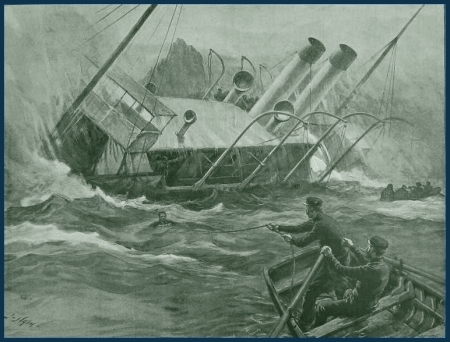
|
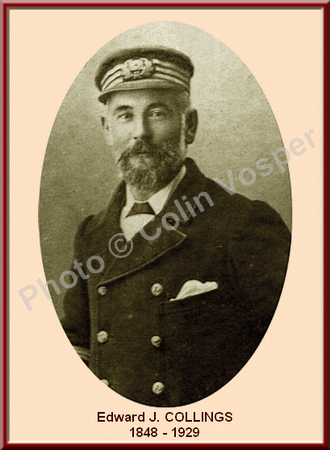 |
|
Illustration du naufrage parue dans The Graphic |
Le Capitaine Collings |
|
Ainsi que
l’avait affirmé le Capitaine Collings, ceux qui étaient restés à bord avec
lui avaient les meilleures chances de survie. Le vent s’était levé et la
marée descendante, en provoquant l’échouage, engendrait à présent une mer
agitée qui déferlait constamment sur le malheureux navire.
Après 3 heures dans ces conditions précaires, les rescapés étaient enfin
rejoints par deux pêcheurs à bord de leur canot “ Try ”. Ils embarquaient les naufragés
les uns après les autres pour les remettre à bord
d’autres embarcations afin de rejoindre le rivage. De cette manière, tous
ceux qui étaient restés à bord allaient pouvoir rejoindre la terre ferme.
Dans le respect des traditions maritimes, le Capitaine Collings quittait le
bord le dernier et prenait pied à terre vers 10 h 35, contusionné et
souffrant de crampes. Le bilan final de ce naufrage s’élevait à 21 victimes
dont 16 passagers au nombre desquels, la petite Dolly Ayres, une fillette de
2 ans qui avait péri noyée quand la cabine où elle dormait s’était emplie
d’eau.
Pour sa part, avec 14 victimes dont plusieurs jeunes garçons, la corporation des Johnnies était frappée en nombre
pour la première fois ; ce naufrage ne devait être, hélas, que le prélude à
un drame bien pire encore, celui du
Hilda sept années plus tard.
Au moins, à la suite de cet accident, la sécurité des parages fut-elle
notablement améliorée avec l'installation d'un feu plus puissant et d'une corne de brume sur les
Hanois.
|
As advised
by Captain Collings, those who stayed with him on the bridge of the
ship had the best chance of survival. The wind was rising and the
tide had turned creating difficult seas which broke over the
stricken ship and with the tide fallng the
Channel Queen was now
aground and being constantly beaten by the waves.
After some 3 hours in their precarious position, the survivors were
finally reached by two fishermen in their boat called 'Try'.
Together these two fishemen rescued the survivors one-by-one and
ferried them to other small boats to be taken ashore. In that way
all those who had remained on the ship were taken ashore to safety.
As one should expect in the true tradition of the sea, Captain
Collings was the last to be rescued and was landed ashore bruised
and suffering from cramp at approximately 10.35 a.m. The final toll
of those lost in the shipwreck was 21 amongst whom were 16
passengers including Dolly Ayres, a toddler aged 2 years who had
been drowned when water flooded into the cabin she was sleeping in.
The 14 Breton victims included several young boys. There had never
before been so many Johnnies lost in one
tragic incident. They were not to be the last as unfortunately
seven years later, the
Hilda was in
her turn wrecked on the reefs off Saint Malo, claiming a toll of
over 120 drowned.
At least, following
the wreck of the Channel Queen, it was decided to improve the safety
along the Guernsey coast and the
Hanois lighthouse was fitted with a more
powerful light and a fog horn. |
Les marées du jour - Tides of the
day
|
SAINT PIERRE PORT |
|
1 Février - 1898 - February
1 |
|
Pleine mer - High
tide |
Basse mer - Low
tide |
|
Heure |
Hauteur |
Time |
Height |
Heure |
Hauteur |
Time |
Height |
|
1 h 30 |
6 m 30 |
14 h 25 |
6 m 25 |
8 h 10 |
4 m 10 |
20 h 40 |
4 m 10 |
|
Edward
James COLLINGS |
|
|
Le
Capitaine du
Channel Queen était né à St. Peter Port, Guernesey, en 1848. Il était
père de deux enfants et titulaire du Master Certificate of Competency
n° HT 102028 délivré en 1877. En 1884 il avait été décoré de la médaille de
bronze de la Royal Humane Society pour acte de courage en sauvant un homme
de la noyade à Sutton Pool, Plymouth*.
Il avait donc 50 ans lors du naufrage et il est décédé à
Plymouth en 1929 à l'âge de 81 ans. Il est inhumé avec son épouse et son
fils, l'Ingénieur Mécanicien Principal Arthur Barry Collings, Royal Indian
Marines, dans le cimetière de St Mary's Church, Plympton. La sépulture est
référencée comme suit : Bloc C Rang 10 Tombe 9. |
The Channel Queen
Master
was born at Guernsey, St. Peter
Port in 1848. He had two children and he was holding a Master Certificate of Competency
n° HT 102028 delivered in 1877. In 1884 he had been decorated with the
Bronze Medal of the Royal Humane society for saving from drowning the life
of a man at Sutton Pool, Plymouth*.
He
was 50 years of age when the wreck happened
and
he died in 1929 in Plymouth aged 81 years. He is buried with his wife and
his son, Engineer Commander Arthur Barry Collings RIM in the churchyard of
St Mary's Church, Plympton. The grave is referenced as: Block C Row 10 Grave
9. |
|
* View the presentation of the RHS in this
excerpt of "The Star"
dated Nov.4, 1884 |
Les
victimes - The victims
|
Equipage - Crew
Harry DAVEY, 25 ans, matelot
F. FUDGE, Chauffeur
John George HAWKINGS, Graisseur
Alfred Vinson SCAWN, 43 ans, Chef mécanicien
Ernest THOMPSON, cuisinier
Passagers - Passengers
Franck COWELL, 35 ans, Représentant de commerce.
Dolly AYRES, 2 ans
Johnnies
Yves ARGOUARC'H, 19 ans, de St Pol
Jean BELLEC 26 ans, de Plouénan
Charles CABIOC'H, 13 ans, de Santec
Claude CORRE 18 ans, de St Pol
Jean-Marie CORRE, 14 ans, de Roscoff
Henri CREIGNOU, 46 ans, de Roscoff
Esprit KERBIRIOU, 26 ans, de Roscoff
François LE BIHAN 42 ans, de Roscoff
Jean-Marie LE BIHAN,10 ans, de Roscoff (fils de François)
Paul LE ROUX, 32 ans, de Roscoff
Yves LE MEN 24 ans, de St Pol
Yves MILIN 17 ans, de St Pol
Joseph TANGUY 59 ans, de Roscoff
François VELLY 19 ans, de Sibiril
|
|
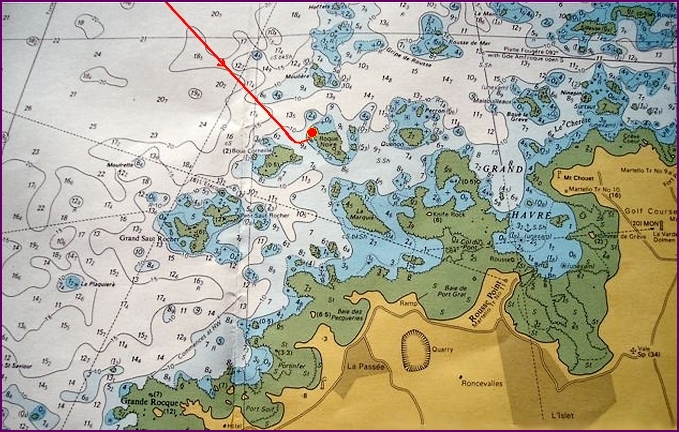 |
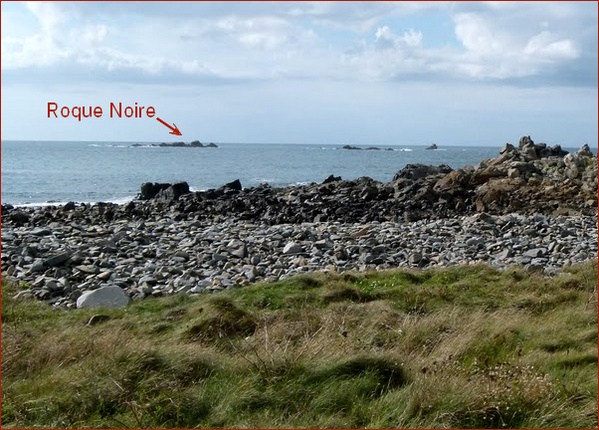 |
|
Les lieux du naufrage
- The shipwreck's place |
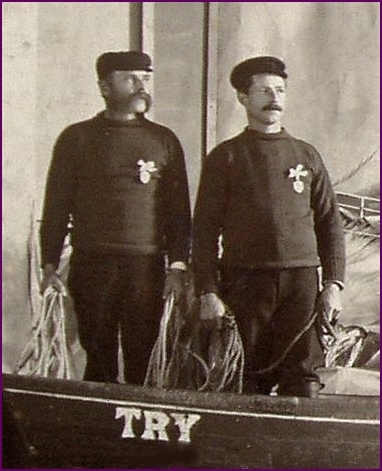 |
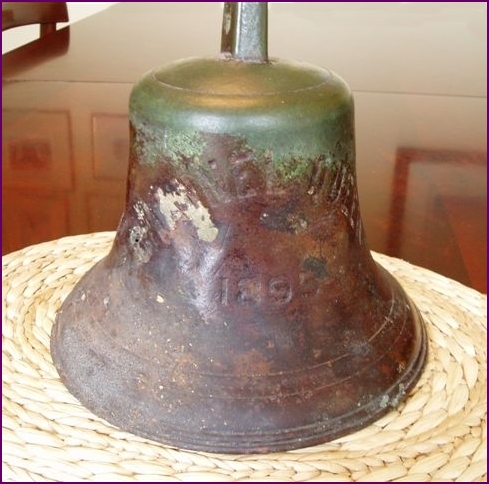 |
|
Les sauveteurs A. Gaudion & G.
Bewey The rescuers |
La cloche du navire - The
ship's bell |
 |
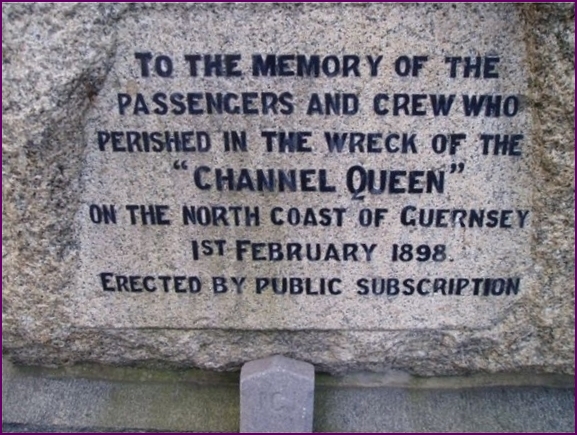 |
|
Cimetière de St Sampson's
Cemetery |
|
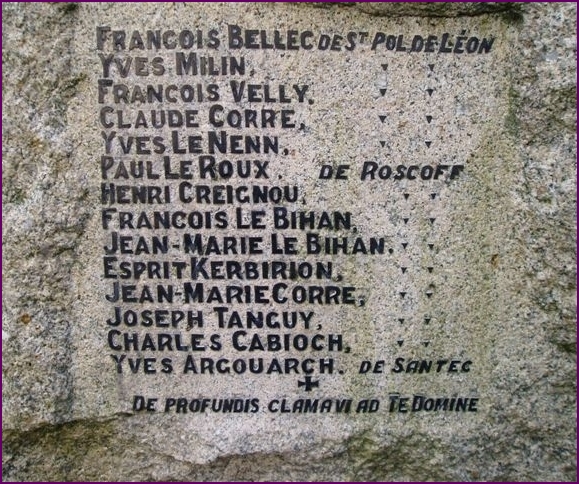 |
|
Les 14 victimes
Johnnies the 14 victims |
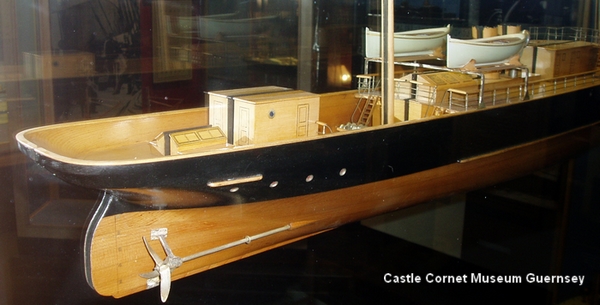 |
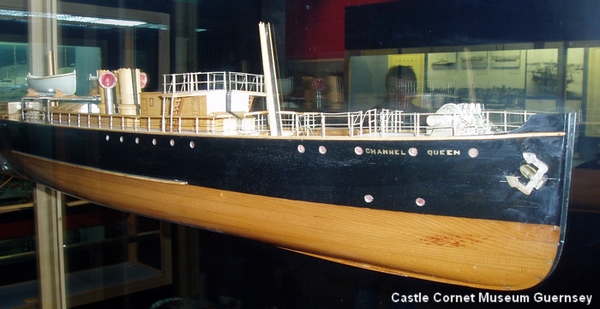 |
|
Maquette du
Channel Queen exposée au Castle Cornet Museum, Guernsey (photo C.Vosper) |
|
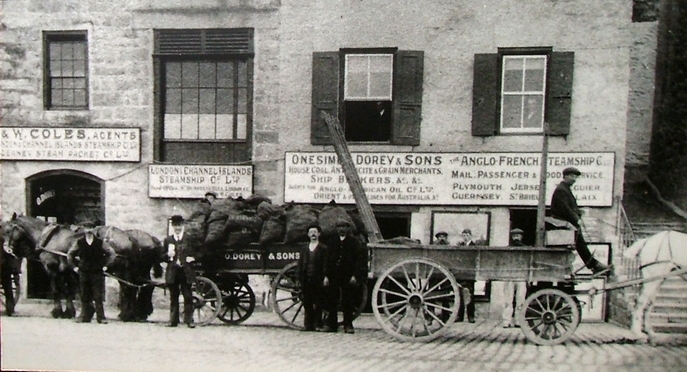 |
|
Les bureaux de
la compagnie - Company's office |
|
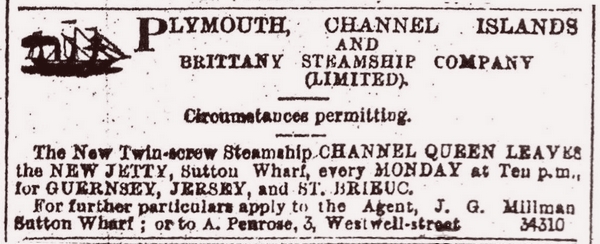 |
|
Circumstances
permitting...
|
|
Ce naufrage a
également été évoqué dans le bulletin paroissial de Roscoff par l'historien
roscovite François Guivarc'h. Ce bulletin est
consultable en ligne
 |
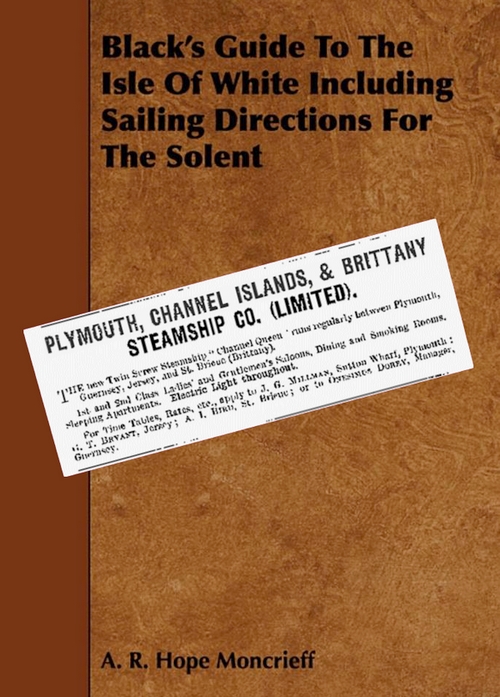 |
Dans ce guide
touristique édité en 1897, la Compagnie avait inséré cet encart
publicitaire :
PLYMOUTH, CHANNEL
ISLANDS, & BRITTANY STEAMSHIP CO. (LIMITED).
The new Twin Screw Steamship " Channel Queen " runs regularly
between Plymouth, Guernsey, Jersey, and St. Brieuc (Brittany).
1st and 2nd Class Ladies' and Gentlemen's Saloons, Dining and
Smoking Rooms,
Sleeping Apartments. Electric Light throughout.
For Time Tables, Rates, etc., apply to J. G. Millman, Sutton Wharf,
Plymouth ; G. T. Bryant, Jersey ; A. I. Bird, St. Brieuc or to
Onesimus Dorey, Manager,Guernsey. |
|
Retrouvez le
récit de cette catastrophe,
dans un
extrait de "1850-1950, Cent ans d'histoires de mer dans la Manche"
- A narrative of the wreck (in french) to download |
|
|
© Yves DUFEIL, 1975

ou lire le récit à
l'écran

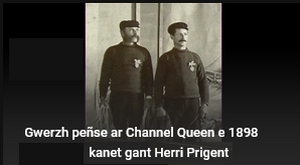
Le lundi 29 mars 2021, Michèle
Segura-Coz a organisé l'enregistrement par Job ar C'heloù Mat de la chanson
concernant le naufrage du Channel Queen chantée par Henri Prigent chez lui à
Santec. C'était un souhait depuis de nombreuses années enfin réalisé.
Merci à Henri et Jeanne Prigent
ainsi qu'à Job.
|
|
Remerciements particuliers à Colin
Vosper, arrière petit-fils du Capitaine Collings pour toutes ses informations et
les
photos - Special thanks to Colin
Vosper, great grand-son of Captain Collings for most of the information and
pictures. |





















